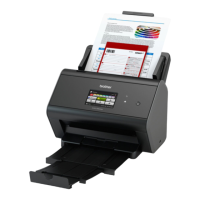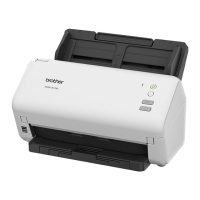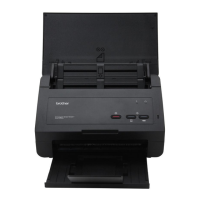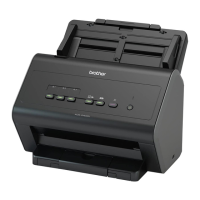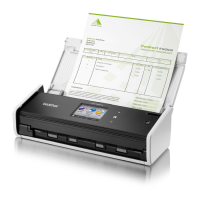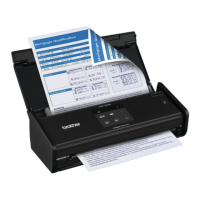Do you have a question about the Brother ADS-3000N and is the answer not in the manual?
Detailed specifications for the scanner's general features, CPU, and memory.
Details on wired and wireless network types, protocols, and security features.
Information on machine life, MTBF, MTTR, and maximum monthly volume.
Lists consumable parts like rollers and their replacement intervals.
Details ADF capacity, paper types, weight, and media size specifications.
Scanner specifications including TWAIN, WIA, ICA, ISIS compliance, color depth, and resolution.
Overview of troubleshooting procedures for common errors and malfunctions.
Safety precautions to prevent secondary problems during troubleshooting.
Pre-repair checks for operating environment, power supply, document, and other factors.
General overview of the scanner's components and internal structure.
Diagram illustrating the internal components and their layout within the scanner.
Diagram showing the paper path from input to output.
Explains the function of each major part of the scanner.
Illustrates the main PCB connections to sensors, motors, and interfaces.
Exploded view showing the key mechanical and electronic components of the scanner.
Details LED status patterns for various error conditions and corresponding troubleshooting steps.
Table mapping LED status to specific problems and their solutions.
Lists LCD error messages, their descriptions, and the relevant troubleshooting section.
Provides step-by-step troubleshooting for common error displays and issues.
Guides on resolving issues indicated by specific error displays on the scanner.
Explains how to diagnose and fix common image quality issues like light, streaks, or dirt.
Specific remedies for different image defects such as light, faulty registration, or blank pages.
Solutions for issues related to document feeding, jams, and multiple feeds.
Troubleshooting steps for when documents get jammed inside the scanner mechanism.
Addresses issues when the scanner doesn't respond to computer operations or fails to read data.
Solutions for issues where the control panel or its LEDs are not functioning correctly.
Steps to resolve problems with scanning via network connection.
Covers troubleshooting for issues like the machine not turning on or firmware update failures.
Essential safety guidelines to follow before and during disassembly/reassembly procedures.
Instructions on how to pack the scanner components.
Visual catalog of screws used in the scanner assembly.
Table specifying screw types, quantities, and tightening torque values.
States that there are no parts requiring lubrication.
Mentions that there are no gears to be disassembled.
Illustrates the routing paths and colors of various internal harnesses.
Visual guide showing the sequence of disassembly steps for major components.
Step-by-step instructions for disassembling the scanner, including cable disconnection.
Detailed steps for removing and replacing the reverse and pick-up rollers.
Instructions for removing the bottom cover and its associated parts.
Steps to remove the back cover of the scanner.
Procedures for removing the left and right side covers.
Instructions for removing the USB host PCB assembly.
Detailed steps for removing the main PCB assembly, including shields and harnesses.
Procedure for removing the left and right front covers.
Steps for removing the entire front cover assembly.
Instructions for disassembling the panel unit and its related components.
Steps to remove the second side CIS unit and associated cables.
Procedure for removing the eject jam sensor PCB and related parts.
Instructions for removing the document scanning position sensor PCB.
Steps to remove the paper feed jam sensor PCB and multi feeding sensor PCB.
Instructions for removing the document detection sensor PCB assembly.
Procedure for removing the first side CIS unit and its flat cable.
Steps to remove the front cover sensor.
Instructions for removing the feed belt and feed motor.
Steps to remove the paper feed belt and paper feed motor unit.
Procedure for removing the multi feeding sensor PCB ASSY (Receive).
Steps to perform after replacing the main PCB, including firmware installation and settings.
Instructions for checking and installing the latest firmware for the scanner.
Procedure to set the country code for the scanner.
Steps to initialize the EEPROM settings of the main PCB.
Procedure to activate memory writing for settings.
Instructions for setting the scanner's serial number.
Procedure to set the threshold for the multi feeding sensor.
Method to verify the operational status of various sensors in maintenance mode.
Steps to check the multi feeding sensor's operation after adjustment.
Procedure to test the scanner's functionality after repairs or adjustments.
Instructions to reset the scanner to its original factory shipping state.
Procedure to acquire white level data and set the CIS scan area after CIS replacement.
Procedure to acquire white level data and set the CIS scan area after CIS replacement.
Steps to set the multi feeding sensor threshold after replacing the sensor.
Steps to set the multi feeding sensor threshold after replacing the sensor.
Guidance on resetting roller counters after replacement.
Guidance on resetting roller counters after replacement.
Explanation of how to enter and use the scanner's maintenance mode.
Overview of available functions within the maintenance mode and their references.
Detailed explanations of specific maintenance mode functions.
Function to change USB number return value for end-users.
Function to initialize user settings and parameters in the EEPROM.
Function to check ADF operation by feeding documents and counting them.
Procedure to test the functionality of various sensors in maintenance mode.
Steps to calibrate the scanner by acquiring white level data and setting the scan area.
Function to save network configuration data to a USB flash memory.
Schematic showing the electrical connections between components and the main PCB.
States that no parts require periodic replacement.
Detailed specifications for the scanner's general features, CPU, and memory.
Details on wired and wireless network types, protocols, and security features.
Information on machine life, MTBF, MTTR, and maximum monthly volume.
Lists consumable parts like rollers and their replacement intervals.
Details ADF capacity, paper types, weight, and media size specifications.
Scanner specifications including TWAIN, WIA, ICA, ISIS compliance, color depth, and resolution.
Overview of troubleshooting procedures for common errors and malfunctions.
Safety precautions to prevent secondary problems during troubleshooting.
Pre-repair checks for operating environment, power supply, document, and other factors.
General overview of the scanner's components and internal structure.
Diagram illustrating the internal components and their layout within the scanner.
Diagram showing the paper path from input to output.
Explains the function of each major part of the scanner.
Illustrates the main PCB connections to sensors, motors, and interfaces.
Exploded view showing the key mechanical and electronic components of the scanner.
Details LED status patterns for various error conditions and corresponding troubleshooting steps.
Table mapping LED status to specific problems and their solutions.
Lists LCD error messages, their descriptions, and the relevant troubleshooting section.
Provides step-by-step troubleshooting for common error displays and issues.
Guides on resolving issues indicated by specific error displays on the scanner.
Explains how to diagnose and fix common image quality issues like light, streaks, or dirt.
Specific remedies for different image defects such as light, faulty registration, or blank pages.
Solutions for issues related to document feeding, jams, and multiple feeds.
Troubleshooting steps for when documents get jammed inside the scanner mechanism.
Addresses issues when the scanner doesn't respond to computer operations or fails to read data.
Solutions for issues where the control panel or its LEDs are not functioning correctly.
Steps to resolve problems with scanning via network connection.
Covers troubleshooting for issues like the machine not turning on or firmware update failures.
Essential safety guidelines to follow before and during disassembly/reassembly procedures.
Instructions on how to pack the scanner components.
Visual catalog of screws used in the scanner assembly.
Table specifying screw types, quantities, and tightening torque values.
States that there are no parts requiring lubrication.
Mentions that there are no gears to be disassembled.
Illustrates the routing paths and colors of various internal harnesses.
Visual guide showing the sequence of disassembly steps for major components.
Step-by-step instructions for disassembling the scanner, including cable disconnection.
Detailed steps for removing and replacing the reverse and pick-up rollers.
Instructions for removing the bottom cover and its associated parts.
Steps to remove the back cover of the scanner.
Procedures for removing the left and right side covers.
Instructions for removing the USB host PCB assembly.
Detailed steps for removing the main PCB assembly, including shields and harnesses.
Procedure for removing the left and right front covers.
Steps for removing the entire front cover assembly.
Instructions for disassembling the panel unit and its related components.
Steps to remove the second side CIS unit and associated cables.
Procedure for removing the eject jam sensor PCB and related parts.
Instructions for removing the document scanning position sensor PCB.
Steps to remove the paper feed jam sensor PCB and multi feeding sensor PCB.
Instructions for removing the document detection sensor PCB assembly.
Procedure for removing the first side CIS unit and its flat cable.
Steps to remove the front cover sensor.
Instructions for removing the feed belt and feed motor.
Steps to remove the paper feed belt and paper feed motor unit.
Procedure for removing the multi feeding sensor PCB ASSY (Receive).
Steps to perform after replacing the main PCB, including firmware installation and settings.
Instructions for checking and installing the latest firmware for the scanner.
Procedure to set the country code for the scanner.
Steps to initialize the EEPROM settings of the main PCB.
Procedure to activate memory writing for settings.
Instructions for setting the scanner's serial number.
Procedure to set the threshold for the multi feeding sensor.
Method to verify the operational status of various sensors in maintenance mode.
Steps to check the multi feeding sensor's operation after adjustment.
Procedure to test the scanner's functionality after repairs or adjustments.
Instructions to reset the scanner to its original factory shipping state.
Procedure to acquire white level data and set the CIS scan area after CIS replacement.
Procedure to acquire white level data and set the CIS scan area after CIS replacement.
Steps to set the multi feeding sensor threshold after replacing the sensor.
Steps to set the multi feeding sensor threshold after replacing the sensor.
Guidance on resetting roller counters after replacement.
Guidance on resetting roller counters after replacement.
Explanation of how to enter and use the scanner's maintenance mode.
Overview of available functions within the maintenance mode and their references.
Detailed explanations of specific maintenance mode functions.
Function to change USB number return value for end-users.
Function to initialize user settings and parameters in the EEPROM.
Function to check ADF operation by feeding documents and counting them.
Procedure to test the functionality of various sensors in maintenance mode.
Steps to calibrate the scanner by acquiring white level data and setting the scan area.
Function to save network configuration data to a USB flash memory.
Schematic showing the electrical connections between components and the main PCB.
States that no parts require periodic replacement.
| Film scanning | No |
|---|---|
| Color scanning | Yes |
| Input color depth | 30 bit |
| Maximum scan size | 215.9 x 355 mm |
| Output color depth | 24 bit |
| ADF scan speed (b/w, A4) | 50 ppm |
| Enhanced scan resolution | 1200 x 1200 DPI |
| Optical scanning resolution | 600 x 600 DPI |
| Duplex ADF scan speed (b/w, A4) | 100 ipm |
| Scanner type | ADF scanner |
| Product color | Black |
| Scan to | FTP, File, HTTP, Image, OCR, USB |
| Sensor type | Dual CIS |
| Scan drivers | ICA, ISIS, TWAIN, WIA |
| Internal memory | 256 MB |
| Built-in processor | Cortex-A9 |
| Processor frequency | 800 MHz |
| Scanning noise level | 63.9 dB |
| Daily duty cycle (max) | 5000 pages |
| Supported network protocols | ARP, RARP, BOOTP, DHCP, APIPA(Auto IP), WINS/NetBIOS name resolution, DNS Resolver, mDNS, LLMNR responder, Custom Raw Port/Port9100, SMTP Client, FTP Client and Server, LDAP Client, CIFS Client, SNMPv1/v2c/v3, HTTP/HTTPS server, TFTP client and server, ICMP, Web Services (Scan), SNTP Client |
| Auto document feeder (ADF) input capacity | 50 sheets |
| ISO A-series sizes (A0...A9) | A4, A5, A6, A7, A8 |
| ISO B-series sizes (B0...B9) | B5, B6, B7, B8 |
| Scanning media types supported | Business Card, Envelopes, Plastic Card |
| Maximum ISO A-series paper size | A4 |
| Auto Document Feeder (ADF) media weight | 27 - 413 g/m² |
| USB version | 3.2 Gen 1 (3.1 Gen 1) |
| Standard interfaces | Ethernet, USB 3.2 Gen 1 (3.1 Gen 1) |
| Power supply type | AC |
| Power consumption (off) | 0.12 W |
| Power consumption (standby) | 4.1 W |
| Power consumption (typical) | 30 W |
| Power consumption (PowerSave) | 2.9 W |
| PC connection | RJ-45 |
| Sustainability certificates | ENERGY STAR |
| Operating temperature (T-T) | 5 - 35 °C |
| Operating relative humidity (H-H) | 20 - 80 % |
| Package depth | 254 mm |
| Package width | 382 mm |
| Package height | 330 mm |
| Package weight | 6200 g |
| Harmonized System (HS) code | 84716070 |
| Depth | 258 mm |
|---|---|
| Width | 306 mm |
| Height | 250 mm |
| Weight | 4450 g |
